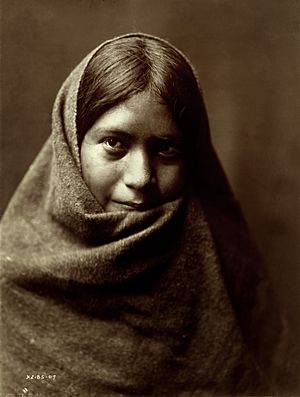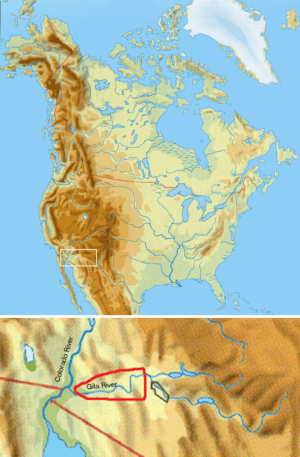Maricopa people facts for kids

Pakit, a young Maricopa woman, 1907
|
|
| Total population | |
|---|---|
| 804 (2015 census) | |
| Regions with significant populations | |
| Languages | |
| Maricopa, English | |
| Religion | |
| Traditional tribal religion | |
| Related ethnic groups | |
| Yuman peoples |
The Maricopa people, also called Piipaash, are a Native American tribe. They live in Arizona, USA. You can find them in the Salt River Pima–Maricopa Indian Community and the Gila River Indian Community. They share these lands with the Pima, a tribe they have been friends with for a long time.
The Maricopa in the Salt River community are mostly Xalychidom Piipaash members. They live mainly in Lehi. Those in the Gila River community live mostly in Maricopa Colony. The Maricopa are a River Yuman group. They used to live along the Colorado River.
Contents
What the Maricopa Are Called
The Maricopa have different names. Their neighbors, the Akimel O'odham (Pima) people, called them Kokmalik'op. This means 'enemies in the big mountains'. The Spanish later changed this name to Maricopa.
The Maricopa people call themselves Piipaa, Piipaash, or Pee-Posh. These names all mean 'people'. Many Maricopa today are descendants of the Halchidhoma people. They found safety with the Maricopa in 1825. Some of them also call themselves Xalychidom Piipaa or Xalychidom Piipaash. This means 'people who live toward the water'.
A Look at Maricopa History
The Maricopa people once lived in small groups along the Colorado River. In the 1500s, they moved to the area around the Gila River. They did this to avoid attacks from the Quechan and Mojave tribes. In the 1840s, many Maricopa people became sick. New diseases caused by contact with outsiders affected the tribe.
In 1825, a group of American trappers attacked about 200 Maricopa people. This happened as revenge for an earlier conflict.
In the 1800s, the Maricopa and Pima tribes became allies. In 1857, they won an important battle against the Quechan and Mojave tribes. This was the Battle of Pima Butte. The Maricopa became very good farmers. By 1870, they grew a lot of wheat. But then, there was a drought, and non-Native people used too much water. This caused many crops to fail.
In the 1800s and 1900s, the Bureau of Indian Affairs (BIA) tried to make the Maricopa live like European-Americans. They brought Presbyterian missionaries to the communities. In 1914, the US government divided the tribe's shared land into smaller pieces for individual families. This was meant to encourage farming in a European-American way. However, this farming method did not work well in the local climate.
In 1926, the BIA created the Pima Advisory Council. This council spoke for both the Pima and Maricopa communities. In 1934, the Indian Reorganization Act was passed. In 1936, the Pima and Maricopa agreed on a constitution. This helped them get back some control over their own government.
During the 1930s, the Gila River dried up. The tribe suffered greatly because they lost their main water source. The BIA did not help with the water problems. The tribe had to use salty well water, which was not good for growing food. So, they started growing cotton to sell instead.
Maricopa Language
The traditional language of the Maricopa people is Maricopa. This language belongs to the Yuman language family.
Maricopa Arts and Crafts
The Maricopa people are well-known for their basket weaving and textiles. They are especially famous for their beautiful red-on-redware pottery. This pottery has a shiny finish. Their traditional pottery skills became popular again from 1937 to 1940.
Elizabeth Hart, a US Home Extension Agent, worked with Ida Redbird. Ida Redbird was a very skilled Maricopa potter. Together, they started the Maricopa Pottery Cooperative. Ida Redbird was the president of this group. It had 17 to 19 master potters. Elizabeth Hart encouraged the potters to sign their artwork.
The Swastika was a common design in traditional Maricopa art. But the Maricopa stopped using this symbol in the 1940s. This was because the Nazis used the symbol, which gave it a bad meaning. Maricopa pottery is made using a special "paddle and anvil" method. Pottery used for cooking has a special material added to make it strong. But decorative Maricopa pottery does not need this.
Famous Maricopa People
- Ida Redbird (1892–1971) – She was a master potter. She helped bring back Maricopa pottery in the late 1930s. She was also the first president of the Maricopa Pottery Makers Association. Ida Redbird helped save her tribe's history by translating and sharing information for a book.
- Robert "Tree" Cody – He is a talented flutist. He is also a member of the Hunkpapa tribe.
Images for kids
See also
 In Spanish: Maricopa para niños
In Spanish: Maricopa para niños




